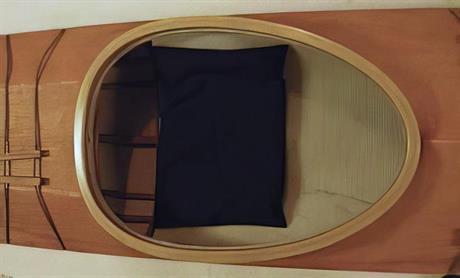Maintenance of skin on frame / Greenland kayaks
Do frame-and-skin kayaks need a lot of maintenance?
No; no more than plastic or fibreglass kayaks. The canvas, of course, is subject to a certain degree of wear and tear, and will therefore need maintenance. This usually consists of light sanding and a thin coat of paint every two or three years. It is important to store it in a dry place.
What's the expected lifespan of a kayak?
Some people enjoy their kayak all their life, but it depends on the owner. There are kayaks in museums that are hundreds of years old and still usable, and there are kayaks built 20 years ago that are useless. With proper treatment, the canvas can easily last 20 years. The frame can last indefinitely and be reskinned when necessary.
If the kayak gets punctured, is it difficult to repair?
You can easily repair it temporarily by patching the hole with duct tape. For safety reasons, you should always keep some tape in the kayak. More permanent reparations are also simple to carry out. You can glue on a patch from the inside, or sew the canvas together, apply putty, and then paint and sand until the repair is no longer visible.
Are canvas kayaks easily punctured?
Definitely not. Many new canvas kayak paddlers fear the day when a sharp rock under the water will suddenly make a huge serration in their kayak. This normally doesn't happen. Many years of use and rough treatment of kayaks show that there is no reason to worry. First of all, there are few sharp rocks along the coast. Most rocks are smoothed by the continuous polishing by the wave action – the exception being rocks that have recently been quarried. I often bump into rocks when paddling among isles and skerries, and the canvas isn't harmed in the least. Second, the canvas is very resilient. It's stretched out over a frame of stringers and ribs, which make it flex if it meets a rock. This gives the kayak a great deal of strength compared to kayaks made from less flexible materials.
Tips and Tricks

Beanbag seat
Here's some advice from a competition paddler: Are your legs and feet getting stiff and numb when paddling for long distances? Make a pillow and stuff it with polystyrene pellets. You can buy them in furniture stores. Make the pillow quite large. The one in the picture measures 30 x 45 centimetres, but don't stuff it too much. You want the tiny polystyrene balls to move freely inside the bag. This seat works especially well in large kayaks, like baidarkas and doubles.

Extra footrest
If your footrest doesn't fit well, or if some other person wants to use your kayak, you can make this simple extra footrest. As seen in the picture, a piece of wood, measuring 50 x 20 millimetres in cross-section, is cut to fit in between the gunwales. Once finished to a perfect fit, you simply squeeze it into place.

Sea sock rucksack
Ståle Beinseth made this smart seasock ruchsack. Two straps sewn onto the sea sock, and you can carry your gear on your back when paddling and taking a break.
Maintenance of Greenland paddles
The Greenland paddle is made to last for a lifetime if treated well. As goes for all other wooden arctic paddles. It's simple and solid. With time, the finish may show some wear and tear from pushing against rock and being knocked around. If your paddle is treated with varnish you should varnish the paddle once every two years. Sand the entire paddle with fine sandpaper and apply a thin layer of varnish. Most oil-based varnishes can be used, but not water-based varnish. If your paddle is treated with oil, you need to reapply oil every once in a while. Kajakkspesialisten sells oil especially for treating wooden paddles.
Below you can get some tips on have to maintain your paddle in perfect shape.
Tips and Tricks

Skeg - Greenland type
You may discover difficulties, paddling in strong side winds. There are many solutions to this problem, but this one is one of the best in my opinion. It is simply a loose skeg, attached to the stern wear strip, using a simple mechanism. For a long paddle in side winds, the skeg is attached. Otherwise, it is stored on deck. With some practice, the skeg can be attached while on the water, with the aid of a second person.

Kayak trailer for your bicycle
Do you want to cut down on car use? a good solution for you might be: A bicycle trailer for your kayak. The one in the picture is made of aluminium. A much more simple way to do it is to fasten a short pole behind your bike. You fasten a strong rubber cord to the end and tie it to the tip of your kayak. The kayak is then strapped to a canoe- or kayak trolley, and off you go!
